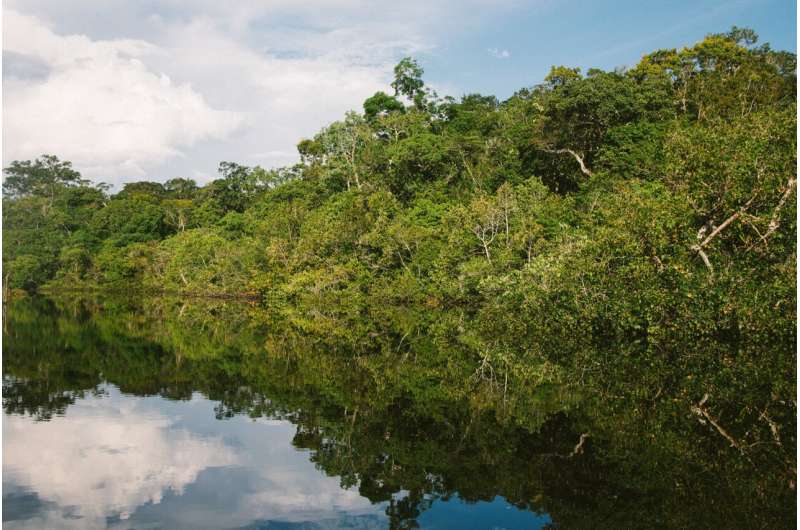This article has been reviewed according to Science X's editorial process and policies. Editors have highlighted the following attributes while ensuring the content's credibility:
fact-checked
peer-reviewed publication
trusted source
proofread
Scientists take a portable laboratory into the Amazon to study adaptation of trees to drought

As an ecologist, Dr. Julia Tavares often has to consider how to collect data from remote locations.
But nothing had quite prepared her for the challenges she faced when she started her Ph.D. at the University of Leeds.
As a doctoral researcher in the School of Geography, she took on the task of organizing and eventually leading an expedition into the Amazon rainforest to record data from the dominant trees that existed at locations ranging from Brazil, Peru and Bolivia.
The study involved overseeing the harvesting of hundreds of tissue samples, work that had to take place in the middle of the night, all in the quest of cutting-edge science.
The research team worked in extreme humidity and temperatures that reached 30°C by eight in the morning and more than 35° by midday. And the hot and humid conditions brought out clouds of mosquitoes.
Involving a collaboration of 80 scientists and support staff, the study was looking at how different tree species had adapted to drought, and how vulnerable different forest zones would be to further climate change.
It was the first investigation into the water stress faced by trees across the entire Amazon basin and how they might cope if, as some climate models predict, the Amazon gets significantly warmer and rainfall patterns change.
The findings of the research have been published today, Wednesday, April 26, in the journal Nature.
Sampling from the tree canopy
Samples were taken from more than 540 trees. These were the dominant canopy species, with some reaching over 30 meters in height. The tissue samples were used to measure how hydrated the tress were, and this fluctuates over a 24-hour period.
The scientists needed to measure hydration during periods of low and high-water stress. To do that, sampling was done at three in the morning—when the rainforest was in utter darkness and plants were recharging their water levels—and again at midday.
As part of the expedition, the scientific team brought a mobile laboratory, packed in 16 flight cases, into the forest along with giant cylinders of nitrogen gas.
Dr. Tavares said, "We had a team of expert tree climbers whose job it was to use ropes and climbing gear to ascend the trees and get the samples.
"We would survey the site the day before we intended to take the samples. Remember, we were working in a dense rainforest and some of the sampling was happening at night, so we needed to mark the trees and the branches that we wanted for the tissue samples."
The trees climbers used what are telescopic scissors, which can extend six or so meters, to reach out across the vegetation and harvest the branch they were after.
Dr. Carol Signori-Muller, an ecophysiologist formerly at University of Campinas, Brazil, and now with the University of Exeter, said the rainforest is a beautiful and fantastic place that took on a different character at night.
She said, "At night it is very dark. The moonlight can be blocked out by the dense overhead vegetation. And it is very silent.
"There is hardly any sound from the birds. All you can hear are the croaking of frogs or the movement of branches. You become attuned to the sounds around you because you need to be aware that something can suddenly appear from behind a bush."
During one off the daytime sampling sessions, a jaguar emerged from the undergrowth and started playing with the ropes attached to the climbing gear, in the way a cat would play with a ball of wool.
Dr. Tavares added, "The team had to stop what we were doing and keep away—and just watch the jaguar, who did end up destroying some of the climbing gear."
Reaching the different forest locations would involve a drive in four-by-four vehicles or by boat and would involve the scientists and support staff camping or staying in field station accommodation.
The team wore long boots to protect themselves from the snakes that live in the rainforest.
The results of the study will help identify those regions of the rainforest at greatest risk from climate change, enabling conservationists to target resources and policies to those areas.
Dr. Halina Soares Jancoski, who took part in the expedition while at the State University of Mato Grosso in Brazil and is now with the Environment Secretariat of the Municipality of Nova Xavantina, in the central west region of Brazil, said, "I consider this study very important because it helps us to understand how forests will behave with the effect of climate change. Especially in the Amazon—Cerrado transition areas, which are more susceptible to climate extremes than in the core areas."
Dr. Tavares added, "At the start of my Ph.D., if you said to me that I would be involved in a major expedition into the Amazon and would have led a scientific collaboration into one of the most important ecological questions facing this hugely important ecosystem, I would have thought you were joking.
"But, together with an amazing team, that is exactly what we have done."
More information: Basin-wide variation in tree hydraulic safety margins predicts the carbon balance of Amazon forests, Nature (2023). DOI: 10.1038/s41586-023-05971-3. www.nature.com/articles/s41586-023-05971-3
Journal information: Nature
Provided by University of Leeds





















